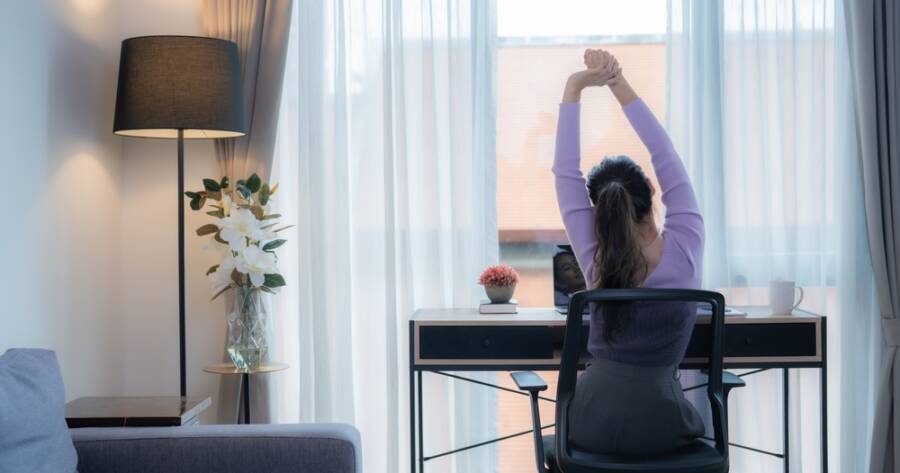Working from home often means spending hours at your desk—sometimes more than you ever did in an office. Without a chair that supports your back, neck, and posture properly, you’re likely to feel fatigue, strain, or discomfort. Investing in an ergonomic office chair designed for long hours is one of the smartest ways to protect your health and boost productivity. Understand what to look for in a chair, as well as key features that matter when you’re sitting all day.
Know What Makes a Chair Truly Ergonomic
An ergonomic chair does more than look comfortable—it actively supports your body while you work. Experts say you should look for adjustable lumbar support, seat depth, and tilt settings so the chair adapts to your body rather than forcing your body to adapt to it.
A good chair also allows your feet to rest flat on the floor, keeps your knees at or just below hip level, and gives your lower back something to lean into with minimal effort. If you’re using your chair eight or more hours a day, these features become essential—not optional.
Top Ergonomic Office Chairs
Several models consistently stand out for combining long-term comfort, adjustability, and build quality. The Herman Miller Aeron remains a gold standard thanks to its breathable mesh design, fully adjustable arms, and excellent lumbar support that automatically adapts to posture changes. The Steelcase Leap V2 earns high marks for its LiveBack technology, which flexes to mirror your spine’s movement while you work.
For a more budget-friendly yet ergonomic option, the Branch Ergonomic Chair offers seat-depth adjustment, lumbar control, and a wide recline range at a mid-tier price point. Those seeking plush cushioning often choose the Secretlab Titan Evo, which merges gaming-chair comfort with serious back support. Together, these chairs prove that investing in ergonomics isn’t just about comfort—it’s about performance and long-term health.
Adjustability Is Key for Long-Term Comfort
When you sit all day, what feels comfortable in hour one may feel different by hour four or five. That’s why adjustability is so important. Look for chairs that offer changes in height, back recline angle, armrest height and width, and headrest position. Tests of many leading chairs show that better adjustability is strongly linked to better comfort and fewer reports of fatigue or back pain.
Mesh-backed chairs are also noted for improved breathability—useful if your WFH space tends to warm up. Seats with waterfall edges (where the front edge slopes gently downward) can reduce pressure on the backs of your thighs, which helps circulation when you’re seated for long stretches.
Support Features: Lumbar, Seat Depth, and Headrest
A common cause of discomfort from sitting too long is inadequate lumbar (lower back) support. A chair that includes a dedicated lumbar support—especially one that can be adjusted for height or firmness—helps you maintain the natural curve of your spine. Several top-rated chairs highlight lumbar support as a major factor in their comfort ratings.
Seat depth matters too: if the seat is too deep, the front edge may press into the backs of your knees; too shallow and you lose support for your thighs. Ideally you should be able to sit back fully and still have two to three inches between the edge of the seat and the back of your knees. A headrest is another useful addition if you lean back often or use the chair for long calls or reading, helping take strain off your neck.
Materials, Build Quality, and Mobility
You’ll be using your chair every day, so the materials and build quality matter a lot. Mesh backs are praised for airflow and comfort over long hours. Foam-cushioned seats remain common and provide better comfort for many users compared to firm plastic. Choose a build that feels sturdy and doesn’t squeak or wiggle during day-long use.
Mobility is also part of comfort. The base should be stable and the wheels suitable for your floor surface (carpet versus hardwood). A reliable tilt mechanism and smooth transition from upright to reclined position help you switch posture easily without feeling like you’re fighting the chair.
Matching the Chair to Your Workflow and Body
Finally, the right chair depends on your body and workflow. If you’re tall or lean forward frequently, a chair with a higher back and stronger recline is helpful. If you switch between desk work and meetings, look for one with a sync-tilt mechanism so the back and seat move together. If you live in a warmer space, a mesh back will keep you cooler.
It’s best to test chairs (if you can) or buy from retailers with good return policies, because what feels supportive for one person might feel wrong for another—even with all the right specs.
Your Chair Matters, Every Hour
Spending hours at your desk isn’t going away, but the pain, stiffness, and fatigue that come with it don’t have to be part of your routine. The right ergonomic chair supports your posture, gives you comfort that endures through the workday, and helps you stay focused rather than distracted by discomfort.
Choose adjustability, proper support for spine and thighs, quality materials, and a chair that fits your body and work style. Your back—and your productivity—will thank you.

